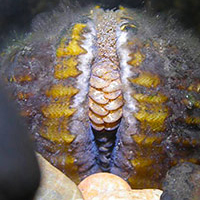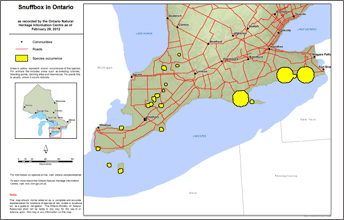Snuffbox
Scientific name: Epioblasma triquetra

Cover photo credit: M C Barnhart, Missouri State University
Status
Endangered
“Endangered” means the species lives in the wild in Ontario but is facing imminent extinction or extirpation.
Date added to the Species at Risk in Ontario List
The Snuffbox was already assessed as endangered when the Endangered Species Act took effect in 2008.
Read the Assessment Report
What it looks like
The Snuffbox is a small freshwater mussel, less than seven centimetres in length, which can be distinguished from other species by its thick, smooth, and triangular-shaped shell.
The shell is often yellow-green with darker green rays that resemble dripping paint.
Where it lives
The Snuffbox is typically found in small to medium-sized rivers in shallow riffle areas.
They prefer clean, clear, swift-flowing water and firm rocky, gravel or sand river bottoms.
Mussel larvae are parasitic and must attach to a fish host, where they consume nutrients from the fish body until they transform into juvenile mussels and drop off.
In Ontario, the main fish host for Snuffbox is the Logperch but other host fish may include various darter species, Largemouth Bass, Mottled Sculpin and Brook Stickleback.
Like all freshwater mussels, the Snuffbox feeds on algae and bacteria that it filters out of the water.
Where it’s been found in Ontario
In Canada, the Snuffbox is now only found in the East Sydenham River and the Ausable River in southwest Ontario.
The total population size is very small. Historically, the species was also found in Lake Erie, Lake St. Clair, and the Thames, Detroit, Grand, and Niagara rivers.
View a Larger version of this map (PDF)
What threatens it
The greatest threats to the Snuffbox are invasive species and pollution from agriculture and siltation, which occurs when too much soil washes into the river from nearby agricultural and urban areas.
The Zebra Mussel, an invasive species from Europe, is a serious threat because it attaches to native mussels and can kill them by interfering with breathing, feeding, excretion and movement.
Conditions that threaten the fish host species can also threaten the Snuffbox.
Action we are taking
Endangered Species and their general habitat are automatically protected
Recovery strategy
A recovery strategy advises the ministry on ways to ensure healthy numbers of the species return to Ontario.
Read the executive summary (September 10, 2010)
Read the recovery strategy (September 10, 2010)
Government response statement
A government response statement outlines the actions the government intends to take or support to help recover the species.
Read the government response statement (June 15, 2011)
Five-Year Review of Progress
A five-year review reports on progress made toward protecting and recovering a species, within five years of publishing a species’ government response statement.
Read the report on progress towards the protection and recovery of 27 species at risk, including Snuffbox (2016).
Habitat protection
General Habitat Protection - June 30, 2013
What you can do
Report a sighting
- Report a sighting of an endangered animal or plant to the Natural Heritage Information Centre. Photographs with specific locations or mapping coordinates are always helpful.
Volunteer
- Volunteer with your local nature club or provincial park to participate in surveys or stewardship work focused on species at risk.
Be a good steward
- Private land owners have a very important role to play in species recovery. If you find Snuffbox in a watercourse on or adjacent to your property, you may be eligible for stewardship programs that support the protection and recovery of species at risk and their habitats.
- Invasive species seriously threaten many of Ontario’s species at risk. To learn what you can do to help reduce the threat of invasive species, visit:
- Farmers and land owners can help improve mussel habitat and keep Ontario’s water safe and clean by maintaining natural vegetation next to creeks and rivers, and keeping pollution and soil from washing into Ontario’s streams and rivers. For more information about programs and funding assistance for eligible land owners visit the Ontario Soil and Crop Improvement Association website at:
www.ontariosoilcrop.org/en/programs/species_at_risk.htm.
Report illegal activity
- Report any illegal activity related to plants and wildlife to
1-877-TIP-SMNR (847-7667) .
Quick facts
- The Snuffbox’s main host is the Logperch, which is known to frequently roll over small stones and gravel in search of food. The Snuffbox waits patiently for a Logperch to come along and touch its shell. The Snuffbox then captures the Logperch in its shell and holds the stunned fish long enough to puff out a cloud of mussel larvae that attach to the fish gills, where they live as parasites that consume nutrients from the fish body. The startled fish is then released.
- Mussels rely on a lot of good luck in order to reproduce. Males release sperm into the water, and if there happens to be a female nearby, she will capture the sperm as she filters water in search of food.
- Aboriginal people harvested mussels for food and to create jewellery and tools. In the 1800s, massive numbers of mussels were harvested from the Grand River to create buttons. Millions were shipped out every year until the 1940s when plastic buttons became more popular.
